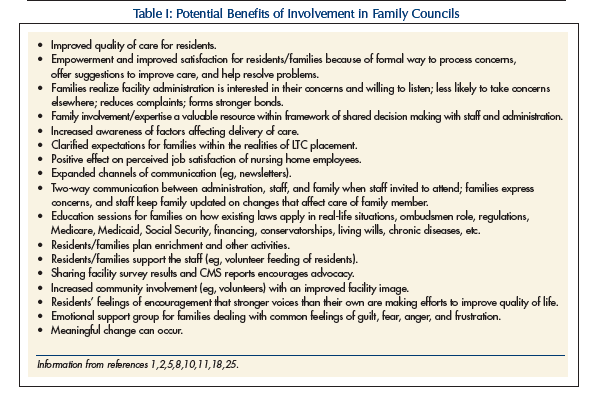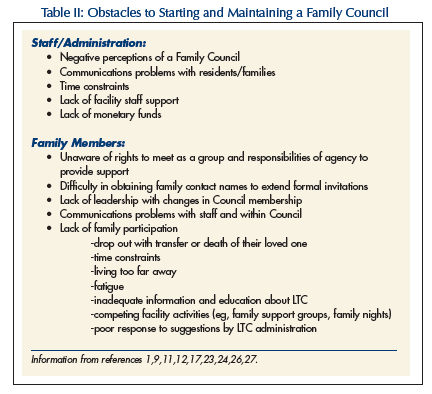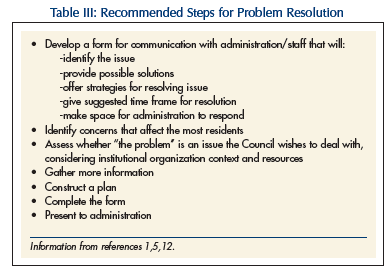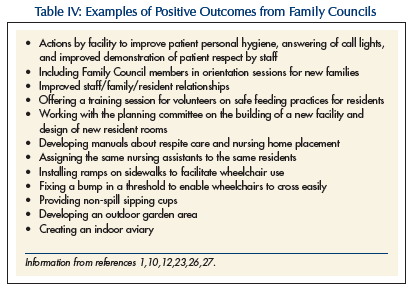Family Councils in Long-Term Care Facilities
A Family Council is an independent, self-determining group of long-term care (LTC) residents´ families and friends. It is geared to family member needs and interests, democratically governed by family members of residents, and sponsored by the LTC facility (LTCF) social service department. Officers are elected from the participants, with a staff member serving as a supportive adviser who participates when requested. State and federal regulations broadly describe the role of Family Councils and provider responsibilities to such groups.1-3 Some state operations manuals specifically state that Family Councils meet to discuss and offer suggestions about facility policies and procedures affecting resident care, treatment, and quality of life.4,5 Though Councils have similar goals, each is unique, evolving to meet members’ interests and needs.1-3,6
Family Council Goals
Goals of the Family Council are to: (1) protect and improve the quality of life in the facility and the long-term care system as a whole; (2) increase consumers’ decision-making opportunities related to families and their residents; (3) provide a formal arena in which problems confronting a significant number of residents can be identified, addressed, and resolved; and (4) provide a means of mutual support for Council members and for families of new residents.1,2,7,8
Specific purposes of the Family Council include:
• Support for families
• Education and information (eg, knowledge about the Residents’ Bill of Rights guaranteed by federal legislation)
• Action on concerns and complaints
• Communication with staff
• Services and activities for residents
• Legislative action1,2,7,8
Because family members are no longer directly responsible for the care of a relative who resides in a LTCF, they may become frustrated. They must deal with intense emotions about deciding to place their relative in a facility, communicating with other relatives, mediating shared decision making with other family members, making decisions related to care, and navigating the new world of Medicare, Medicaid, Social Security, and other healthcare-related issues. Family members may have unrealistic expectations, and they may be afraid to communicate concerns to the staff. They may not be aware of their rights or those of the resident, or how to interpret the facility’s policies and procedures. They may not have had the opportunity to meet other residents’ families and develop a supportive network within the LTCF. A Family Council can provide a way for a family to feel more involved with the care of their loved one, and to have a formal means of communication with others who have similar concerns and questions. The potential benefits of family involvement in Family Councils are listed in Table I.

Family Council Structure and Function
Active membership in Family Councils depends on facility size, but membership is generally equivalent to about 10% of the patient population.2 Most Councils report six to ten active members,9 and meetings are held monthly.5,10,11 It is recommended that meetings be held in the evening7 and last no longer than 1.5 hours11 because of member work schedules and other time constraints. These factors aid in participation and retention of members.2,11,12 Six to eight members are the recommended maximum for group decision-making. When a Council is large, a small group of officers meets regularly, calling other members together as needed, and for social events and special speakers.13,14 Because Councils with a formal structure and structured meetings have better long-term attendance,12 election of officers within the Council is recommended.2,11,12
Legislative Support for Family Councils
The 1987 Nursing Home Reform Amendments to the Social Security Act identifies the right of a resident’s family to meet in the facility with families of other residents. Federal regulations are the same for all states under the 1987 Omnibus Budget Reconciliation Act (OBRA‘87) legislation. In accordance with these regulations, nursing homes certified for Medicare and/or Medicaid will:
• Provide a private meeting space
• Cooperate with the Council’s activities
• Listen to and respond to the Council’s concerns
• Recognize that the staff and visitors may attend meetings only by invitation
• Appoint a designated staff person as a liaison to provide assistance and respond to written requests from the Council
• Listen to disparate views
• Act upon grievances and recommendations related to proposed policy and operational decisions affecting resident care and life in the facility3,5-7
Family Night – Precursor to Family Councils
The idea of giving residents and families a voice in discussing common problems or complaints is not new. A town hall–style gathering sponsored by the LTCF is often called “family night.” 10,14 Appreciative family members acknowledge benefits from these informal meetings, including increased respect for the efforts of nursing staff and fewer complaints by family.10 LTCF residents and their families, however, frequently lack knowledge of their rights and the ability to advocate for themselves. Family nights may provide educational or social functions sponsored by the LTCF for family and friends of residents.14
Through an occasional family night, formal Family Councils can spontaneously evolve within LTCFs.15 Some state laws recommend that assisted living facilities have Family Councils. For example, Minnesota’s Advocacy Center for Long-Term Care facilitates a statewide development program for Family Councils.15 Though Family Councils are recommended within nursing homes and must be supported when they exist, the number of Councils operating within nursing homes has been found to be less than 50% in U.S. facilities.4,12
(Continued on next page)
Quality Improvement
In 1998, Canada’s Ministry of Health and Long-Term Care established a Family Council Project.1 As a result, the number of Family Councils increased in Canada (30% in 2003 versus 14% in 1999), and Family Councils became established as an important component of quality assurance in Canada’s long-term care system. Family Councils had a positive impact on the physical and emotional environment of the LTCF, contributing to the quality of life among long-term care residents. Tension between the staff, family, and friends of residents was reduced, while quality of care improved.1 Attitudes, relationships, and the frequency and quality of contact with family members can have an impact on residents and their care. Family members who can relinquish their guilt about placing an older person in a LTCF experience better adjustment. If the family members’ adjustment is improved, then quality of life for the resident ultimately improves.11,12,16-19 Strong relationships between involved family members and facility staff lead to improved care. Facility quality improves when residents or their representatives are involved to the greatest degree possible in decisions affecting the residents’ lives.8 Inquiring about the presence of a Family Council is recommended when evaluating and comparing LTCFs.3,20
Starting a Family Council Efforts to start a Family Council may begin with the LTCF administrator, a facility staff member such as a social worker, family members, resident advocates (ie, ombudsmen), or funded projects.2,7,11,12,21 A major initiative of the long-term care Ombudsman Program (LTCOP), established by Congress in the 1970s, is to help start, support, and act as a resource to Family Councils, which is one way to provide a community presence in LTCFs.22 LTCOPs offer free manuals and assistance to anyone interested in beginning a Family Council.7
Although numbers may be small, it is likely that there will be enough motivated families in a nursing home setting to support a Family Council. Allowing members to determine their own pace and set realistic goals is important to the functioning of any Family Council, but particularly those with small numbers.2 One way to bridge leadership gaps as membership fluctuates is to have the Council act in small groups and to share officer positions.23
Overcoming Obstacles
Numerous obstacles can interfere with formation of a successful and active Family Council (Table II). Enlisting the support of the local LTCOP is vital to overcoming these obstacles. LTCOPs can support a Family Council by offering:
• A resource center where brochures, videos, and books are available, including a manual specific to Council initiation and functioning
• Guest speakers or help in identifying local speakers
• Active Council participation
• Regular newsletters7,22,24,25
Having a liaison, most often a staff social worker, is also commonly cited as critical to Council success.9,12,13 The advisor can bridge the leadership gap with changing membership, and can serve as a sounding board at Council meetings. When invited to attend, the advisor can help identify issues and realistic solutions.

Communicating Effectively
Communication issues vary from interpersonal problems within the Council, communicating with administration, or lack of ways to distribute Family Council announcements (eg, membership drives, meetings, activities).12,26,27 In the beginning, it is important that all affected by the Council understand its purpose to reduce resistance.1 At times, the Council may be perceived as a formal way to complain, interfering with staff decision making, diluting administrative authority, or demanding of excessive staff time.1,2 Once the Council has clearly identified its purpose and goals as recommended by the LTCOP, these can be communicated to residents, families, administration, and staff. This may be done through meetings offered at various times, bulletin boards, a brochure, or a staff appreciation day sponsored by the Family Council.1
Education programs that stress interpersonal communication techniques can be helpful, such as Partners in Caregiving (PIC).26,27 PIC included parallel training sessions on communication and conflict resolution for family and staff at 20 nursing homes. The program was positively evaluated by participants, with family–staff relations improving and reports of complaints declining. All participating nursing homes made changes as a result of the program, which included establishment of Family Councils at some facilities. Such programs require little additional expense and can assist Family Councils to function more effectively. For this type of training program, support from LTCF administrators is critical.
On a smaller scale, the Council can sponsor educational sessions on effective communication techniques, as well as other topics. Areas often needing educational programming include structure of the Council, administration/meeting logistics, recruitment/outreach, advocacy/follow up, information (eg, patient rights, LTCF regulations, taxes).9,24,25
(Continued on next page)
Marketing the Family Council
Ways to distribute information about a Family Council and to recruit members can include: posted notices on cars outside the LTCF; educational programming within the community; publicity in local newspapers, television, and radio; formation of a membership committee within the Family Council; and use of small reminder/business cards to pass out to family members when they visit.9 Newsletters can be developed and distributed by the Family Council.24,25 Lack of funds can be a major problem, so some Councils sponsor fundraising events.11 Orientation sessions held by the LTCF for new residents and their families and friends can include a Family Council member to discuss Council purposes and activities.10 At orientation, names and addresses of interested participants can be taken to contact them in the future, since families are often too overwhelmed initially to consider becoming active members. Once time for the transition has passed (at least 3 months28), there should be a measure for follow-up.
Resolving Problems
When identifying issues or problems requiring Council action, Bailey1 and Harpel12 recommend a prescribed, written protocol for resolution or agency approval. Recommended steps for problem resolution are found in Table III. It is discouraging when changes are not instituted following recommendations by Family Councils. It is crucial that facility administration seriously consider concerns and implement suggestions when possible.1 Nursing homes are required to respond to Family Council concerns, but there are ways to help increase the chances of a positive response. These include having administrative support for a Family Council from the beginning and a clear understanding of the goals of a Family Council, utilizing appropriate communication techniques (such as a well-thought-through written proposal), and being willing to help make the recommended changes take place.1,2,7

Common Complaints
Complaints about nursing homes noted at a national level in the United States include accidents caused by improper handling of residents, requests for assistance unheeded (ie, call lights not answered), routine personal hygiene neglected, inadequate care plan or resident assessment, lack of respect for residents, poor staff attitudes, bland or monotonous menus, physical abuse, errors in medication administration, and faulty condition of equipment or building (eg, odors, disrepair, hazards, poor lighting, fire safety).29 Although yearly state inspections are required for nursing homes that participate in Medicare and/or Medicaid, state inspectors may miss or not report serious deficiencies affecting residents’ health, including severe weight loss, multiple falls resulting in broken bones and other injuries, and seriously advanced but avoidable pressure ulcers.30
Issues and Outcomes
In addition to the emotional support Council members offer each other and the freedom to speak out,1,10 recommendations often lead to an increased quality of life for residents of the LTCF.1,2,5,11,12,15,18,26,27 Administrators who favor Family Councils see the Council as a venue for suggesting changes and addressing issues before they become crises.23 Family Councils address both small and large issues affecting patient care. Specific examples of positive outcomes are found in Table IV.

Positive outcomes occur because Council members are motivated to take an interest, note problems, and work with administration/staff to solve them. Council members can acknowledge facility limitations, yet recognize staff for what they can do, educate themselves and the community about LTC and the role of a Family Council, participate in organizational activities, sponsor fundraisers, and utilize resources.
Conclusion
Family Councils in LTCFs can be effective in improving family–staff relationships, as well as monitoring and improving the quality of care for residents. It is often difficult to maintain an active Council because the membership of Family Councils is fluid. Family members of residents are busy with work and their own lives, and when a LTCF resident dies, members most often discontinue their participation. Facilities can provide direct support through a facility liaison and by helping to recruit members and communicate the existence and activities of the Family Council. Strong leadership by a facility liaison, an ombudsman, or active family members is vital to Council operation.
LTCF administrators without a Family Council in their facility need to make all family members aware of the purpose and process for starting one. Providing educational sessions on communication skills and conflict resolution can improve Council functioning. While some LTCFs may be hesitant to start a Family Council for fear of its negative impact (eg, increased number of complaints), there is the potential for families to become more empathetic and supportive of the facility and staff as involved families develop realistic goals and establish meaningful programs.
While federal and state laws outline how to support the operation of a Family Council, the existence of a Council is not mandated. Laws identifying the role of the facility in supporting Family Councils need to be expanded, because promoting Council activities has the potential of improving family-resident-staff relationships, reducing the number of complaints, and ultimately improving the quality of care for residents.










